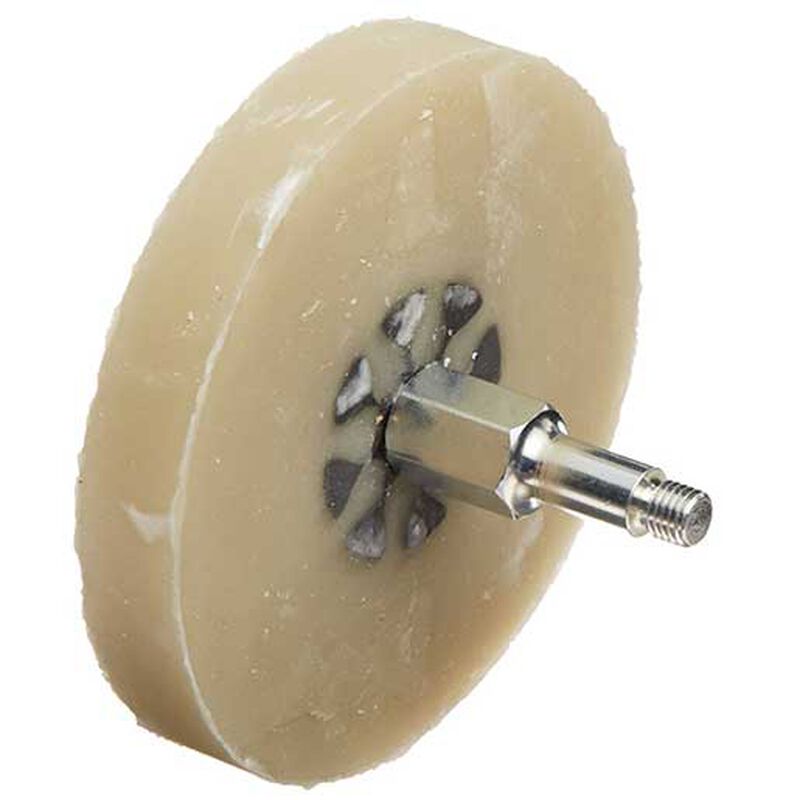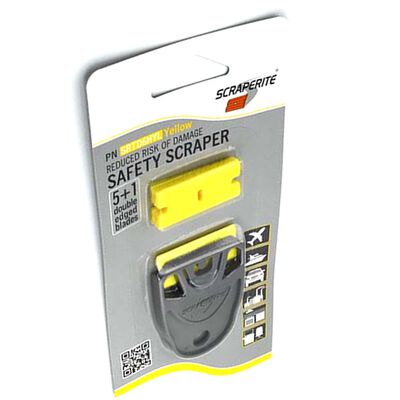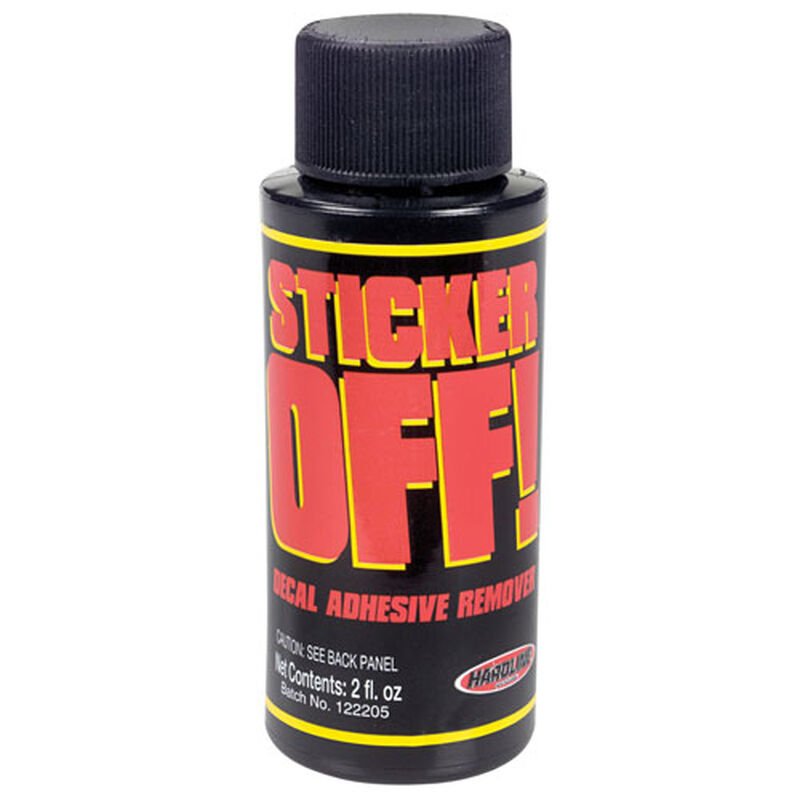Custom self-adhering vinyl graphics, striping tape and letter and number decals are a popular choice for adding a personal touch to boats. However, for various reasons, you may wish to remove or replace these decals. The process of removing vinyl decals requires careful attention to avoid damaging the underlying surface. This article provides you with a step-by-step process for safely removing vinyl decals from your boat.
Before you begin the decal removal process, gather the following supplies:
- Heat gun, hair dryer or eraser wheel (Choice depends on removal method.)
- Plastic razor blade or scraper
- Denatured alcohol or adhesive remover (We suggest Hardline’s Sticker Off! or for large jobs, Debond’s Marine Formula Adhesive & Sealant Remover.)
- Soft cotton or microfiber cloth
- Boat soap
- Rubbing compound (May or may not be needed)
- Wax (May or may not be needed)
Step 1—Wash the surface:
Start by washing off the decal and the area around it with a solution of boat soap and water. This will remove any dirt, grime, or residue on the surface.
Step 2—Remove the decal:
Removal of the graphic can be accomplished with the use of a heat gun (or hair dryer) and a plastic razor blade scraper or with an eraser wheel.
Heat Gun Method
With a heat gun set to “low” or a hair dryer set to “high”, apply heat to the vinyl decal. Move the heat source in a back-and-forth motion, keeping it a few inches away from the surface. The heat will soften the adhesive underneath the decal, making it easier to remove. Be careful to not apply too much heat, as overheating the decal can result in damage to the underlying surface and in the decal coming off in small pieces rather than in larger pieces, the latter being what you want.
Once the decal is heated, gently lift one corner using the plastic razor blade scraper. Slowly peel back the decal at a sharp angle. Work small areas at a time and don’t rush. Slow and steady wins the day! Apply additional heat as needed to loosen stubborn areas, taking care not to overheat the surface. After you remove the decal, some adhesive residue will normally remain, which you can remove, following Step 3 below.
Eraser Wheel Method
Using a 4” eraser wheel attached to a pneumatic or electric drill running at around 2,000 rpm, apply the wheel to the decal and work small areas at a time. In most cases the wheel will remove the decal in small pieces, leaving some adhesive residue behind, which you can remove following Step 3 below.
Step 3—Remove residual adhesive:
After removing the decal, you may notice adhesive residue remaining on the boat's surface. This can be removed with denatured alcohol or with an adhesive remover solvent specifically formulated for this purpose. Moisten a clean microfiber cloth with the solvent and gently rub it over the surface, using small circular motions. Repeat this process until all the residue has been removed.
Step 4—Clean and polish:
Once all the adhesive residue is removed, clean the area again with a solution of boat soap and water to eliminate any traces of the adhesive remover. Rinse thoroughly and dry the surface with a clean cloth. At this point, you may notice a “ghost” image of the graphic that you have removed. This may be due to oxidation of the surface that surrounded the graphic or due to atmospheric contaminants staining the surrounding area. In either case, for how to polish out oxidation and remove stains from gelcoat surfaces, see our West Advisor article Gelcoat Care and Restoration.
Frequently Asked Questions for Removing Vinyl Decals from a Boat
What is the best way to remove vinyl decals from a boat?
The best method for removing vinyl decals from a boat involves using a combination of heat, patience, and the right tools. Here's a step-by-step guide:
Can I remove boat decals without damaging the paint or gel coat?
Yes, you can remove boat decals without damaging the paint or gel coat if you follow the proper steps. The key is to avoid using excessive heat and force. Heat should be applied carefully to soften the vinyl and adhesive, not to scorch or damage the underlying surface. Using gentle scraping tools like a plastic scraper instead of metal will also prevent scratches.
If you are concerned about damaging the surface, start with a small, less-visible area to test the process before proceeding to larger sections.
Do I need any special tools for decal removal?
While you don’t need specialized tools, there are a few items that make the job easier:
- Heat gun or hair dryer: To soften the vinyl and adhesive.
- Plastic scraper or plastic putty knife: For gently lifting the decal off the surface.
- Adhesive remover: Products like Goo Gone, 3M Adhesive Remover, or Isopropyl alcohol to remove sticky residue.
- Soft cloths or rags: For cleaning and wiping off residue.
- Buffing compound (optional): For polishing the surface after removal to restore shine.
Some boat owners also use a decal removal wheel (a rubber wheel that attaches to a drill) to make the process faster, but this is usually for larger decals or tougher adhesives.
How do I remove stubborn adhesive residue after peeling off the decal?
Stubborn adhesive residue can be removed using a few different methods:
- Goo Gone or 3M Adhesive Remover: These products are formulated to break down adhesives. Apply to the residue, let it sit for a few minutes, and then wipe it away with a soft cloth.
- Isopropyl alcohol or mineral spirits: These are effective for dissolving sticky substances. Be cautious with alcohol on certain finishes, as it may affect the shine of some gel coats.
- After removing the residue, clean the area with soap and water to remove any leftover solvent or cleaner.
Is there a risk of damaging my boat’s gel coat or paint when removing decals?
If done improperly, yes, there is a risk of damaging your boat’s gel coat or paint. Here are some tips to minimize that risk:
- Avoid excessive heat: Too much heat can soften or damage the gel coat. Use a heat gun or hair dryer on a low setting and keep it moving to avoid overheating any one spot.
- Use plastic tools: Always use plastic scrapers rather than metal tools to avoid scratching the paint or gel coat.
- Test on a small area: Before tackling the entire decal, test your removal method on a small, inconspicuous area to ensure it doesn’t cause any damage.
- Go slow and steady: Don’t rush the process—pull the decal off slowly, and be patient with removing any adhesive.
Can I reapply new vinyl decals after removing the old ones?
Yes, you can reapply new vinyl decals after removing the old ones, but it's important to prepare the surface properly:
- Clean the surface thoroughly: Make sure the area is free from dirt, oils, and adhesive residue. Use soap and water, followed by a wipe with isopropyl alcohol to ensure a clean surface.
- Polish the surface: If needed, use a polish or buffing compound to restore any shine that may have dulled during the removal process.
- Dry completely: Allow the surface to dry completely before applying the new decals to ensure proper adhesion.
Conclusion:
Removing vinyl decals requires patience and careful attention to detail. By following the step-by-step process outlined in this article, you can safely remove decals without damaging the underlying surface. When using a heat gun, remember to use appropriate heat. Use plastic, non-marking scraping tools, and adhesive removers to achieve the best results. With a little effort, your boat will be ready for fresh decals or graphics to give your boat the look you desire.










